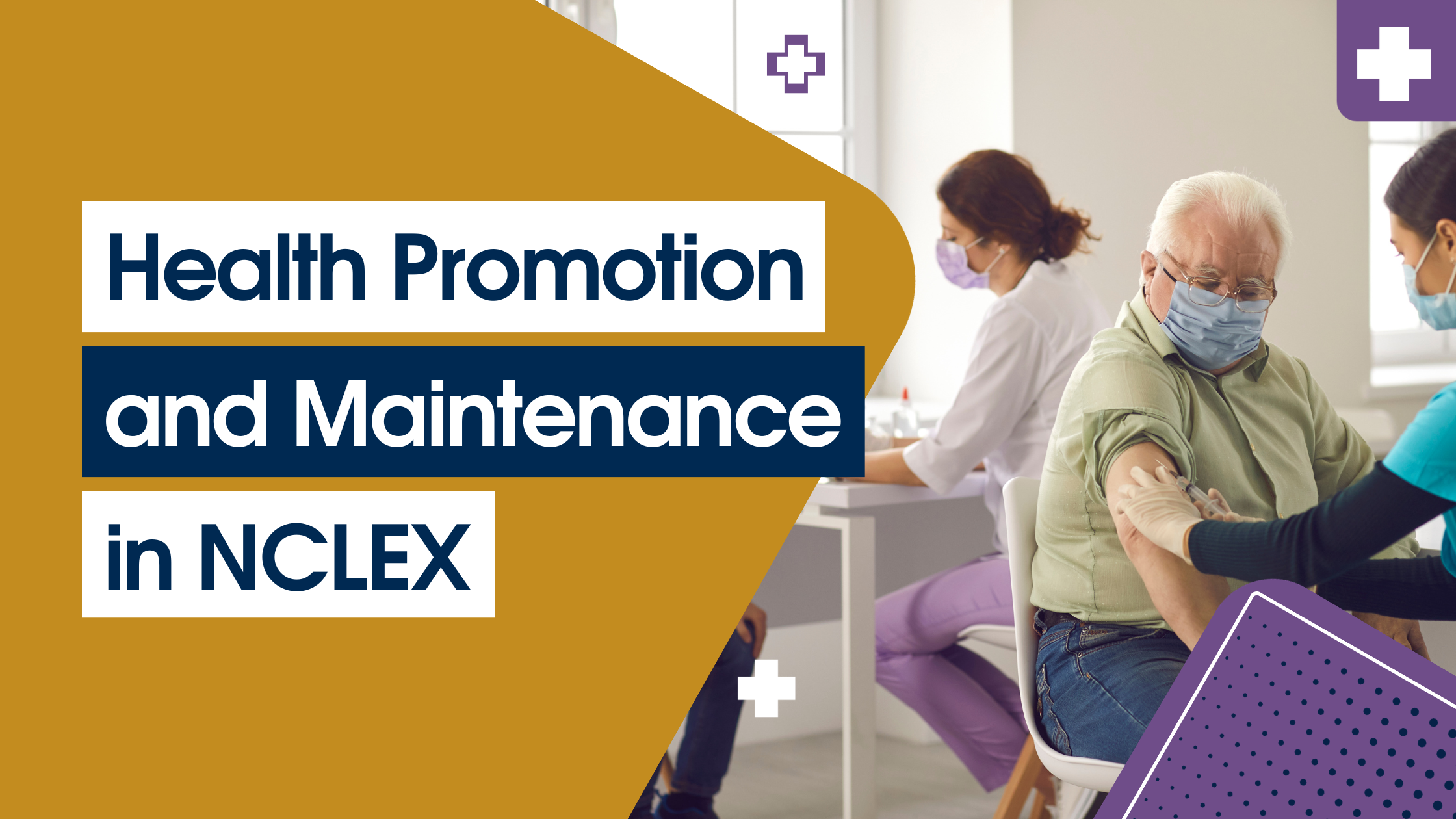NCLEX covers a wide system and programs that you must master, not only to pass this examination but also for your patient’s safety. This section covers the aging process and the things you must know. Aging is normal for every human in the world, but so are the challenges, changes, and difficulties that come with it. You must be able to show your mastery of how to take care of and manage these factors.
Aging Process
You will be expected to demonstrate your knowledge and skills of the aging process in this portion of the NCLEX-RN examination in order to:
- Examine the client’s reactions to anticipated age-related changes.
- Care and instruction are provided for newborns less than one-month-old through the infant or toddler client through the age of two years.
- Preschool, school-age, and adolescent clients aged 3 to 17 are cared for and educated.
- Adult clients from 18 to 64 years old should receive care and education.
- Adult clients aged 65 to 85 years old should receive care and education.
Examine the client’s reactions to anticipated age-related changes.
People react differently to expected age-related changes, as they do to all changes. Some of these reactions cause the client to respond in an adapted and healthy way, while others can be dysfunctional, maladaptive, aberrant, and unhealthy. Nurses must therefore examine all clients’ responses to anticipated age-related changes and plan their treatment based on these assessed responses and reactions to their anticipated age-related changes.
Humans grow and develop in a fairly predictable manner from conception to old age. There are also typical age-related changes that occur throughout the lifespan. These changes can include fairly predictable bodily changes, predictable developmental changes, psychological, cognitive, and emotional changes, and social changes.
Care and instruction are provided for newborns less than one-month-old through the infant or toddler client through the age of two years.
Neonates
Neonates are assessed according to the five criteria of the APGAR score which are A for appearance, P for pulse, G for grimace and reflexes, A for appearance in terms of skin color, and R for respiratory rate and effort. Each of these criteria is scored from zero to two with a zero as no activity or the poorest possible color
A newborn’s physical size ranges from 18 to 22 inches in length, 12 to 13 inches in chest circumference, and 12.6 to 14.5 inches in head circumference.
The normal neonatal abdomen is round; bowel sounds should appear within a few hours of delivery, the umbilical cord and site should be clear of infection indications such as redness and pus, and the neonatal belly should move up and down with respirations.
The neonate’s skin should be free of blueness, jaundice, and cyanosis, with a soft, smooth texture and some typical creases. Vernix caseosa, a thick cheesy material over the skin, fine hair called lanugo, small red spots called milia, telangiectatic nevi, often known as stork bites, purple-blue Mongolian patches, and port wine stains termed nevus flammeus are also common on the skin. The port wine stains, on the other hand, can be persistent and disturbing to the parents.
Infants
According to Jean Piaget’s cognitive development stages, the infant is in the sensorimotor stage, and Erik Erikson’s trust vs mistrust stage of psychosocial development. Separation anxiety and fear of strangers, even nurses, begin as the child begins to see himself as distinct from others. They communicate using noises and sounds, and they are communicated with through touch and sounds. Rattles, big balls, and teething toys are examples of age-appropriate toys.
Falls, poisoning, drowning, and burns are all common injuries and accidents in infants. Because newborns are at the oral stage of development and prone to placing foreign bodies in their mouths, aspiration and poisoning are significant hazards.
Toddlers
The toddler grows around 3 inches per year and gains four times the weight of the child at birth. Toilet training is finished throughout the toddler years, and by about fifteen months of age, the child walks without hanging onto anything. They can jump by the age of two and a half.
Toddlers progress from Piaget’s sensorimotor to the preoperational stage of cognitive development; the child’s vocabulary expands, and the toddler can now speak and communicate in short but meaningful phrases. They are aware of parental boundaries and discipline.
Age-appropriate toys include large and colorful toys that cannot be put in the mouth, picture books, and blocks. Although toddlers interact with other children and siblings, this is more of a parallel game than true interactive play. They play with other children in close proximity, but they do not engage with them in the same way that older children do.
Toddlers are vulnerable to downing, falls, aspiration, burns, car accidents, and suffocation.
Preschool, school-age, and adolescent clients aged 3 to 17 are cared for and educated.
The Preschool Child
Age-appropriate toys include large, colorful toys that cannot be put in the mouth, picture books, and blocks. Although toddlers play with other children and siblings, their play is more parallel than interactive. They play alongside other children but do not interact with them in the same way that older children do.
Downing falls, aspiration, burns, vehicular accidents, and asphyxia are all risks for toddlers.
Poisonings, drownings, burns, and vehicular accidents are all common injuries within this age range.
Preschool toddlers begin to engage with others and ask many “why” questions. Dressing up, role acting, drawing, puzzles, and reading simple books with lots of illustrations are all excellent preschool activities.
Preschoolers are in Piaget’s stage of preoperational and can speak in whole sentences. According to Erik Erikson’s psychosocial developmental phases, the preschool kid is at the initiative against guilt stage. Gender identification is full, and gender-related activities are increasing. Some preschoolers can understand simple explanations about the human body and illnesses. A simple picture, a puppet, and a simple picture book can sometimes help a child understand.
School Age Child
With each growth spurt, a school-aged child’s height, weight, and muscular mass rise. These changes necessitate an additional 2,500 calories per day, as well as more calcium, iron, and vitamins, particularly vitamins B and A.
The school-age youngster now favors same-gender friends, and they may begin to question and criticize their parents and other authority figures, such as teachers and healthcare providers. concerns of the unknown, bodily mutilation, death-related concerns, and failure are all common.
According to Jean Piaget, their stage of cognitive development is concrete operations, and they have a full grasp of their native language and vocabulary by the age of twelve. Erikson’s stage of superiority versus inferiority characterizes the school-age years. Peers become more influential, morality evolves, and sexual curiosity emerges. Sports, board and computer games, and pet care are examples of age-appropriate hobbies.
The most common incidents and concerns among this age range are burns, vehicular accidents, substance abuse, and drowning.
Adolescents
The adolescent’s vital signs are now the same as the adult’s.
Adolescents have increased nutritional and caloric needs due to the growth spurt in which the skeletal and muscular systems double to completion. Vitamins, protein, and calcium requirements must be addressed. Because of menstruation, women require iron supplements. Some teenagers may develop bulimia or anorexia nervosa, both of which are eating disorders.
Adolescents finish the final stage of Piaget’s formal operations. They are in Erikson’s identity versus role confusion stage, and they are starting to think about and plan their future, including their employment and post-secondary education.
Substance misuse, weapon injuries, burns, car accidents, sexually transmitted illnesses, and unexpected pregnancy are all common dangers, accidents, and injuries for this age group.
Adult clients from 18 to 64 years old should receive care and education.
The Young Adult
Young adults typically create and maintain relationships, some of which are long-term and permanent. They take on adult responsibilities such as being a spouse, being a parent, and earning a living. They also take ownership of their own views, attitudes, opinions, values, and actions.
Significant others may be a spouse or partner, children, friends, in-laws, or coworkers. Raising children, finding and maintaining a profession, finances, and managing various roles are typical concerns for this age group.
Physical development is complete; the young adult is still in Piaget’s final stage and Erikson’s closeness vs isolation phase.
Auto accidents, weapon injuries, substance addiction, and sexually transmitted infections are all common injuries and incidents.
Middle Aged Adults
Erikson’s generativity versus stagnation stage applies to middle-aged adults; primary stressors include the loss of youth, motherhood, and the empty nest syndrome. This age group is known as the sandwich generation because people of this age group are frequently pressed and conflicted between caring for their children and caring for their aging parents.
Eye tests for glaucoma and Dexa screening for osteoporosis are among the health tests for this age range.
Adult clients aged 65 to 85 years old should receive care and education.

In terms of growth and development, this age group experiences normal aging changes such as sensory and neurological changes, cardiovascular changes, musculoskeletal changes, joint and bone changes, renal system changes, hepatic functioning changes, skin and hair changes, respiratory system changes, and fluid and electrolyte changes. All of these normal aging changes were thoroughly covered in the section headed “Changes Associated With the Aging Process” below.
According to Erikson, adults 65 and older are in the ego integrity versus despair phase. Caloric requirements are lower than in other age groups. Falls and accidental poisonings are two of the most common safety concerns among the elderly.
Importance of Caring for All Ages
As nurses, you are expected to provide great care to people of all ages. It’s not easy because there’s a lot to learn, but with an understanding of each aging process, you will be able to grasp what is important about each healthcare management.
At AuRNPathway, we will make sure that you will be prepared and equipped with the right knowledge and skills to provide exemplary health care and management.



